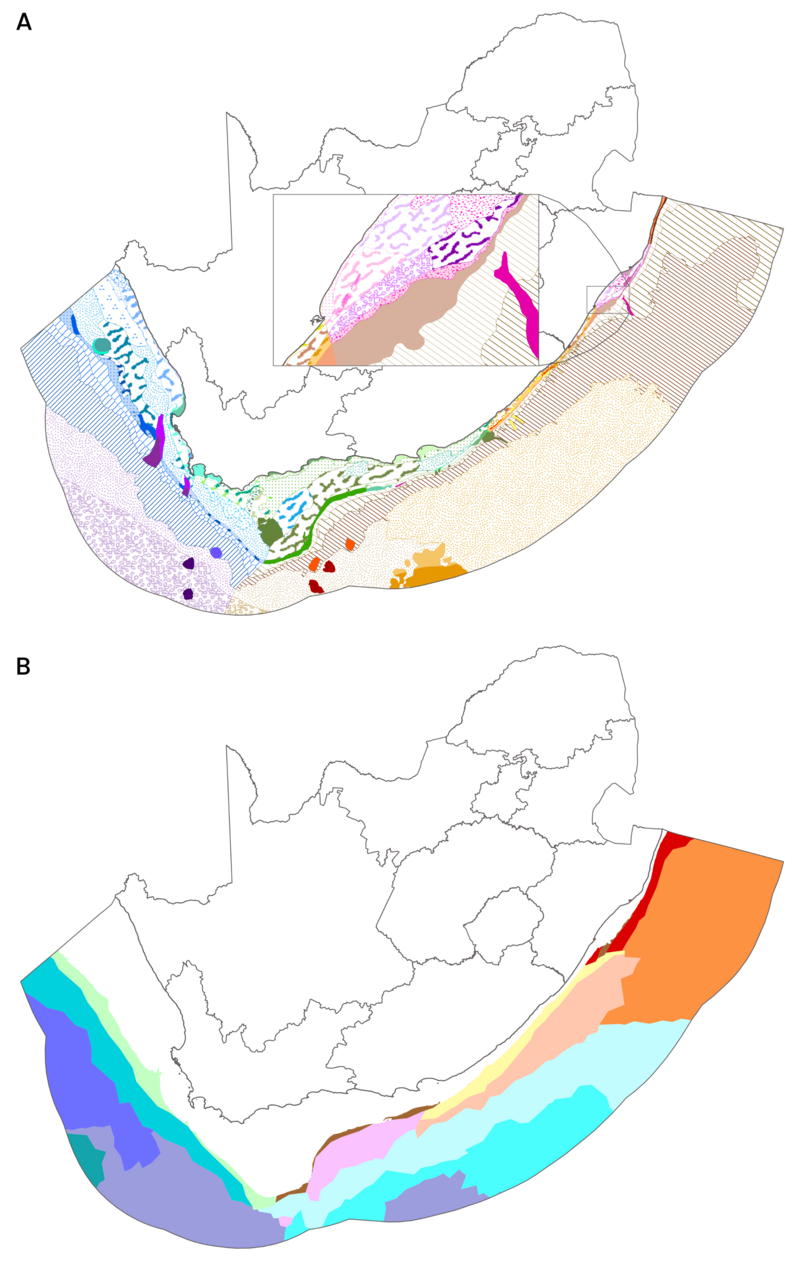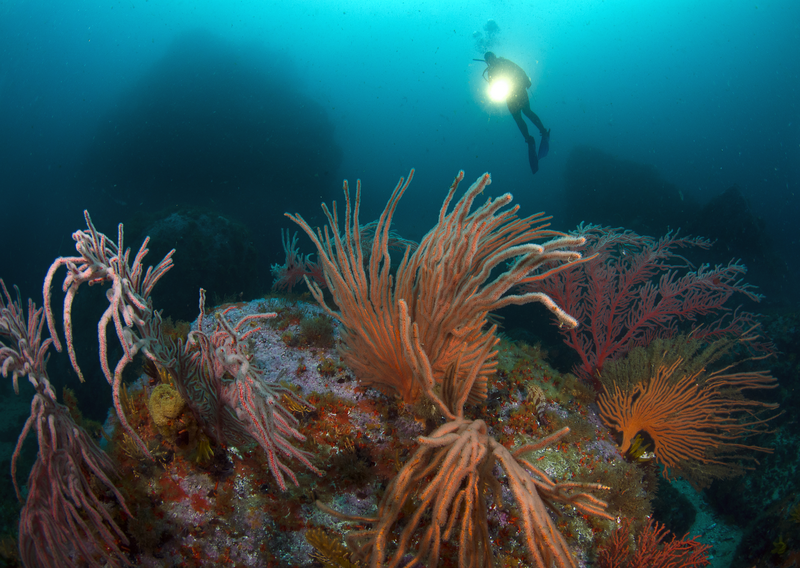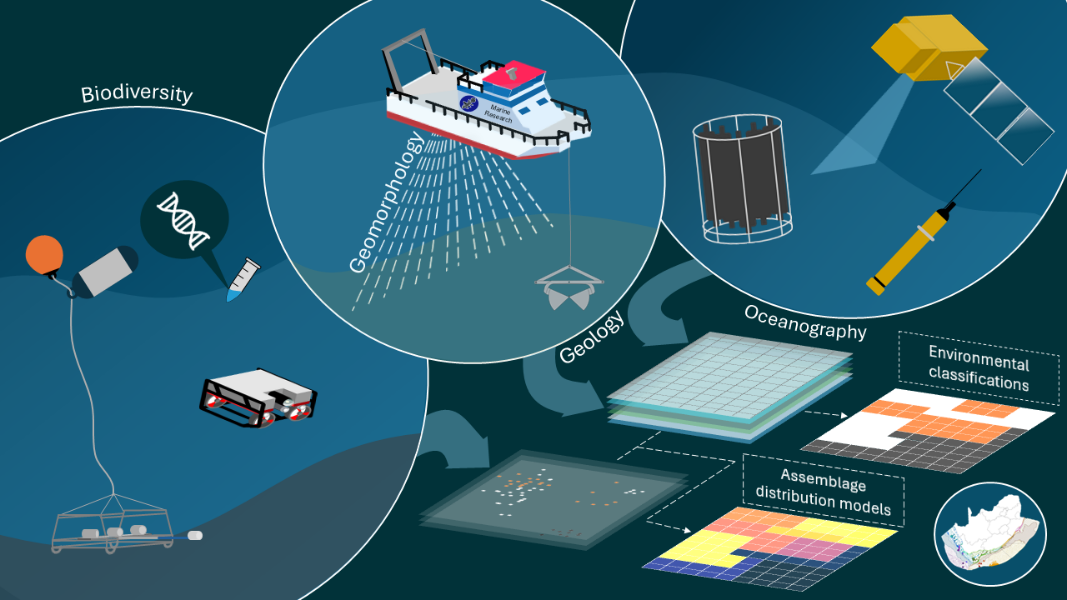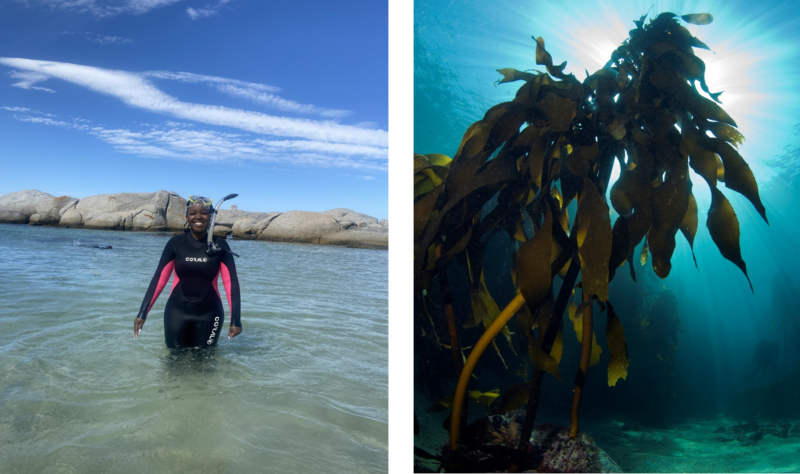
South Africa’s marine environment includes the Atlantic, Indian and Southern Oceans. The contrasting cold Benguela upwelling region and the warm, fast flowing Agulhas current interact with a diverse topography and geological setting to drive exceptional marine biodiversity and high endemism. South Africa is iteratively improving the map of marine ecosystem types as our knowledge of the ocean grows. The latest, 2023 Marine Ecosystem Map contains 163 ecosystem types that nest within 17 Ecosystem Functional Groups in alignment with the IUCN Global Ecosystem Typology (GET). Progress is underway to leverage rapidly expanding marine data for improved ecosystem mapping. Further investment in data science capacity will be critical to integrate expanding knowledge into robust ecosystem classifications, assessments and plans.




Marine ecosystem types
The 2025 National Biodiversity Assessment used the 2023 Marine Ecosystem Map (Figure 1) to assess the state of 163 marine ecosystem types around mainland South Africa. See the subantarctic territory page for an overview of the marine ecosystem types in the Prince Edward Islands. South Africa’s mainland maritime domain (territorial seas plus exclusive economic zone) extends from the dune base to 200 NM seaward, representing an area of approximately 1.07 million km2 and extending to a depth of about 5 500 m. The continental shelf width varies between ~2 and 260 km, and the shelf break depth ranges between 80 and 600 m, being terraced in places (de Wet and Compton, 2021). The Agulhas Bank is a 116 000-km2 triangular extension of the continental shelf that supports many endemic species. Shelf areas constitute approximately 40% of the mainland maritime domain with slope and abyssal ecosystems constituting the remaining 60%. South Africa has a coastline length of over 3 000 km. A separate coastal chapter covers the ecologically determined coastal zone.

The 2023 Marine Ecosystem Map includes 128 shore and shelf ecosystem types which are considered benthopelagic, with 22 deepsea benthic and 13 deepsea pelagic ecosystem types (Figure 2). These 163 ecosystem types nest within 17 Ecosystem Functional Groups (Figure 2) that align with those of the IUCN GET, except for minor differences in terminology, and South Africa included Bays as a distinct group. The Ecosystem Functional Groups are nested within bathomes, which represent geomorphological depth categories equivalent to ‘biomes’ in the IUCN GET.
Approach
Since 2004, South Africa has followed an approach that iteratively improves the classification and mapping of marine ecosystem types1. The Marine Ecosystem Map is informed by a broad range of data (Figure 3) derived from many types of surveys, including bathymetric, geological, oceanographic and biodiversity research. It is a large collaborative effort and the 2023 Marine Ecosystem Map was developed with contributions from 29 authors from 18 different institutions. The map classification follows a nested hierarchy and the 2023 version sought to align with the IUCN GET structure.

Updating the Marine Ecosystem Map
Like its predecessors, the 2023 Marine Ecosystem Map relied heavily on thematic approaches and expert-informed decision-making. Technological advancements are continuously improving our ability to monitor and survey ocean spaces, rapidly increasing the data available to characterise, delineate and understand marine ecosystems. Work is ongoing to update and improve the next version of the Marine Ecosystem Map, which will inform the following National Biodiversity Assessment.
SANBI is implementing data and analytical frameworks to leverage the rapidly escalating volumes of ocean data to improve the Marine Ecosystem Map. This framework consists of a collection of scripted and documented workflows hosted in online project repositories. The scripted workflow components can be updated as new data or better methods become available, can be maintained despite turnover in staff and guiding experts, and are making inroads towards more transparent and reproducible science. This data-driven and reproducible approach has included collation of a suite of environmental gridded data layers and biodiversity survey datasets.
In regions where sufficient biodiversity data occur, the environmental layers and occurrence records are combined in statistical assemblage distribution models that estimate the co-occurring species assemblages and their preferred habitats, thereby predicting biodiversity patterns and characterising their composition. In regions where insufficient biodiversity data have been collected for the biodiversity analyses, gridded environmental layers are combined in environmental classifications (cluster analyses) to delineate unique habitats (Figure 3). The outputs from the assemblage distribution models and the environmental clusters are used as evidence, together with published biogeographic patterns, to consider updates to the ecosystem map. Updates to ecosystem components or types, such as newly mapped submarine canyons and kelp forests mapped from satellite data2 are being incorporated in the ecosystem map.
The updated environmental layers have been organised by topical project groups, which include oceanography, geology and geomorphology. A suite of oceanographic (physical, chemical and phytoplankton) variables for surface and seafloor depths were downloaded from the Bio-ORACLE platform and calculated from Copernicus Marine Service satellite products and regional ocean model hindcasts provided by SAEON and SOMISANA. Updated sediment data were sourced from collaborators, greatly increasing the inventory of marine sediment sample and seafloor description records. Interpolated maps of sediment characteristics were additionally sourced from dbSEABED. Geomorphological variables included a new, national-scale, 100-m resolution bathymetry map9, from which derived variables such as slope angle, bathymetric position index and rugosity were calculated.
Significant strides were also made in the collation of marine biodiversity records in a biodiversity occurrence database. Data were sourced from online data repositories, such as OBIS and GBIF and requested from a network of collaborators at a variety of government and tertiary research institutions. In October 2025, the database contained 1 310 081 records from 7 726 marine species and 12 data sources, representing a growing collection of biodiversity data in waters around South Africa. Although only a selection of marine survey datasets have been used in assemblage distribution models, the vision is to build a comprehensive biodiversity database that will enable presence-only modelling of biodiversity patterns and species turnover across broad taxonomic groups sourced from many datasets.
The adoption of reproducible data and analytical pipelines marks a shift in ecosystem mapping methods, one that should improve efficiency, transparency and foster greater understanding and confidence in the resulting ecosystem map, which informs biodiversity management, spatial planning, and conservation efforts in South Africa. Further investment in data science will be needed to curate and integrate rapidly expanding data streams if South Africa is to maintain a robust evidence base to underpin improved ecosystem classification, mapping, assessment, planning, mainstreaming and decision-making.
Technical documentation
Code repositories
Data
Key publications
Dayaram, A. et al. 2021. The South African National Ecosystem Classification System Handbook, First Edition. South African National Biodiversity Institute, Pretoria.
Sink, K.J. et al. 2023. Iterative mapping of marine ecosystems for spatial status assessment, prioritization, and decision support. Frontiers in Ecology and Evolution 11: https://doi.org/10.3389/fevo.2023.1108118
Recommended citation
Sink, K.J., Currie, J.C., Besseling, N.A., Adams, L.A., Mzimela, N.Z., Dunga, L.V., Hambile, N., & Dayaram, A. 2025. Ecosystem Types: Marine realm. National Biodiversity Assessment 2025. South African National Biodiversity Institute. http://nba.sanbi.org.za/.

